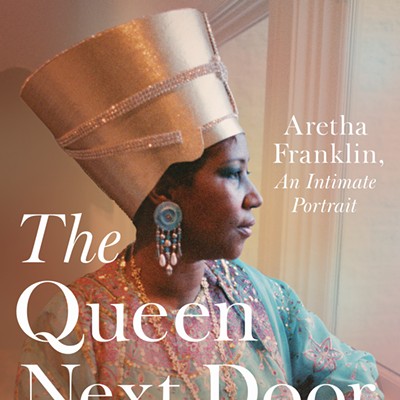Writers from Jonathan Franzen (The Corrections) to Jonathan Safran Foer (Everything Is Illuminated) have chronicled the tragicomic rise of capitalism in the ruins of the Soviet economy, Franzen in Lithuania and Safran Foer in the Ukraine. Photographer Emmet Gowin, in a show last winter at the Center for Creative Photography, exhibited pictures of Czech mines and vast wastelands of environmental degradation. Even Olympics television commentators chime in, explaining the Romanian penchant for gymnastics.
But in isolated America, we don't often hear from Eastern Europeans themselves. A small show in Tucson right now gives a quartet of Poles the chance to stage their own show-and-tell. Trained at Polish universities and art schools, some of these photographers are too young to have strong adult memories of life under the Soviets, who lost power back in 1990. Still, their exhibition at WomanKraft Gallery, GLOB-ALL? Young Polish Women Photograph Their World, offers up a kaleidoscopic portrait of Poland in the years since Solidarity vanquished the Communists at the ballot box.
In some ways, their work points out just how similar we're all getting in these global times. Their up-to-the-minute technology and pop-art sensibility would be familiar to advertisers and art students anywhere in the Western world. Violetta Kus makes digitized color pix of fashionistas trying out fresh identities in crayon-colored rayon and Lycra. Joanna Zastrozna's computer manipulations yield painterly color pictures that are both erotic and nightmarish.
Katarzyna Majak does use traditional equipment--an old-fashioned, 35-millimeter camera--to make traditional black-and-white contact prints, but her subject is the decay of Poland's old world, made visible in crumbling city walls and a peeling plaster Jesus. And Katarzyna Fortuna, perhaps the most visually gifted of the four, makes bright color photos of weary young people drowning in a sea of capitalist clutter.
Fortuna is one of those photographers who can turn disorder into beauty, transforming random debris into elegant compositions. "1 a.m. Yellow Triptych" is a series of three pungently colored prints picturing the late-night ennui of a young woman--one suspects it's Fortuna herself.
The setting is a messy apartment whose vaguely modern furnishings would be unremarkable in Warsaw, New York or in any complex around the UA. A white couch is backed up against a white wall; a cheap bookshelf is crammed with electronic equipment; and a square coffee table is home to dirty mugs, cigarettes and an empty whiskey bottle. Four more empties are on the floor, along with expensive running shoes, and their owner is fast asleep--or passed out--on the couch. Still, she clutches her lifeline, a black electronic box, either a remote or a cell phone.
In the second picture, the woman makes an effort to sit up, but she's unable to raise her head higher than her chin. In the third, she's given up and collapsed completely onto the couch, burying herself under a blanket. Two other triptychs tell a similar cinematic tale. In "1 a.m. Blue Triptych," the star is a young woman in high-fashion red, pictured in various stages of inertness on a blue couch in a blue room. In "1 a.m. Brown Triptych," the heroine has finally made it into her bed.
These glossy pictures show off Fortuna's skill with color--the yellow light bathing "Yellow Triptych" is particularly fine--but the world they depict is uneasy. The figure is forever restless, tossing and turning or holding her head in her hands. In Poland's brave new world of trendy consumption, she's got plenty of stuff, but she's far from content.
Kus uses stuff, too--in her case, clothing--to probe identity, though her work is not as visually interesting as Fortuna's. In "Partners," Kus has made nine color pictures of couples in stylish attire, but she's cropped off their heads and allowed their clothing to speak for them. You can either watch the pictures on a DVD, which heightens their connection to commercials, or look at them framed on a wall. The framed images could be magazine ads, brightly printed as they are against stark white backgrounds that signify everywhere and nowhere. Kus has even used the advertiser's trick of adding text to image. The phrase "endlessness of emotions" goes with a woman in a red top and jazzy print bell bottoms; "I am myself" accompanies her partner, a proudly nerdy man in Polartec jacket and tan corduroys.
The wildest work belongs to Zastrozna. She's got a nightmarish vision (you only hope these are not the dreams of the sleeping girl in Fortuna's photos) that feature angular devils, erotic women glowing white-hot and orange, and a pregnant woman of the proportions of the Venus of Willendorf. In one panel of "Messenger Triptych," a devil in a jock strap waves his arms like a conjurer while a naked woman curls up in the air at his direction; in another, a blue woman in fishnets offers her breasts to a phallic ray of red-orange light. Zastrozna's techniques are pure 21st century, but she taps into age-old human fears about sexuality and fertility.
Majak, a Warsaw photographer who organized the show, follows the old-fashioned route of taking her camera out into the streets. But what she sees--and shoots--is the disarray of the Poland of her forefathers and foremothers. The tiny, blurry (sometimes impossibly blurry) photos picture stucco crumbling off stone walls. Fading outdoor paintings peel away, like layers of the past dissolving.
In one wall painting that Majak photographed for an untitled work, a butterfly catcher in a bowler hat and long coat pursues his flying prey. But this charming scene on a stone building, from the 19th century perhaps, is not long for this world. It's almost gone already, fading away into history, and below it, the 21st century intrudes. Trash cans on the sidewalk are piled high with junk, perhaps the trash from the apartments inhabited by the young consumers in Fortuna's and Kus' photos. All that new stuff from the new world of capitalism--broken computer monitors and toasters not built to last and clothing with a short shelf life--will soon enough obliterate the butterfly catcher and his lost world.














